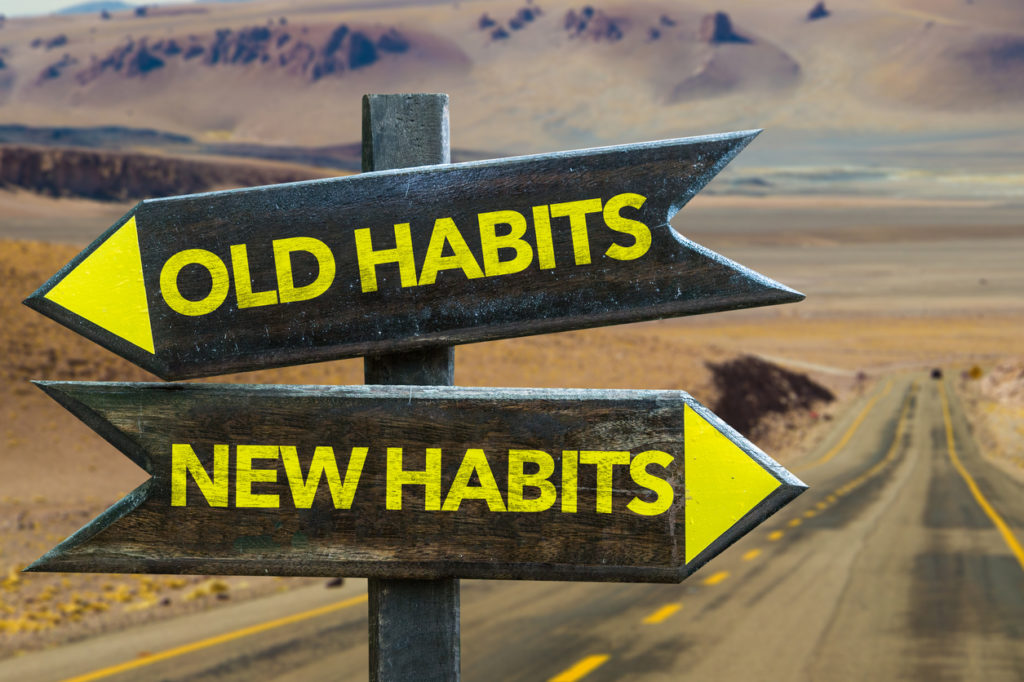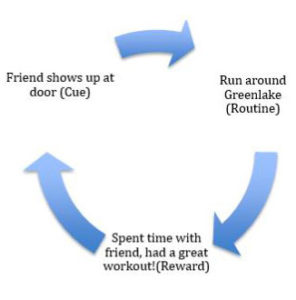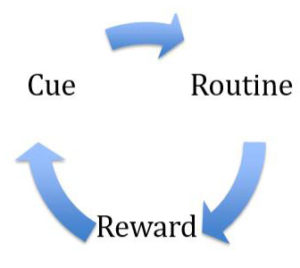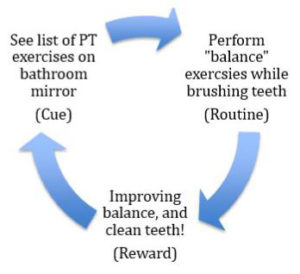Teaching Your Brain to Crave Healthy Habits

By Mylan Vu, DPT, OCS, MTC
Have you ever tried to create a healthy habit for yourself? Perhaps it was to eat better, sleep more, read nightly, or do your physical therapy exercises more regularly? After you decided to make this change, how long was it before you fell back into old patterns? It can be frustrating trying to get these new habits to stick! So, what’s the key? It comes down to building a habit and craving this habit as part of your daily life.
What is a habit?
Habit is defined as any regularly repeated behavior that requires little or no thought; it is learned through reinforcement and repetition (1). In other words, a habit is an automatic action. A benefit of an automatic response is that it is efficient. It becomes part of what we do, allowing us to complete these tasks effortlessly without wasting energy or brain-power. Which is great, because we are already having to do so much thinking and planning with scheduling our day, finishing work, and getting to appointments!
How a habit is formed
According to the European Journal of Social Psychology it takes 66 days to create a habit (3). From a neuroscience perspective, it has been found that the basal ganglia may be the key part of the brain that is responsible for habit formation. It is the part of the brain that is central to recalling patterns and acting on them, it’s also associated with memory and associated emotions (4). This part of our brain integrates learned behaviors, and can help turn them into an automatic routine (5). So, how do we tap into this part of our brain to create and crave good habits?
The Three “Magic Steps” for habit formation
Researchers from the University of Southern California have suggested that forming these habits requires three steps: behavior repetition, creating the same situation or cue, and receiving a reward following this routine behavior (6,7). This concept is thoroughly discussed by Charles Duhigg, author of the book, “The Power of Habit.” (Worth a read and a big inspiration for this blog!) He has described this process as a “habit loop” which is denoted in picture below (2,5):
Cue: this is a trigger for your brain that allows it to go into automatic mode. These triggers can be a time, environmental, a preceding event, an emotion you feel, or something physical such as seeing a person or an object (8).
Examples:
- Time: “At 5PM, it’s time for me to ______”
- Location: “When I am at the mall I always ______”
- Environmental: “When sitting in front of my computer, I feel the need to _____”
- A preceding event: “After I put on my socks I will put on my______”
- Emotion: “I’m sad so I will eat all of this____ ”
- Physical: “Whenever I see my friend, we always ____”
Identifying and choosing a cue is important in initiating this “habit loop”. If trying to achieve this habit daily, choosing a cue that you consistently encounter is ideal so that it will automatically trigger a routine.
Routine: this is the actual activity or behavior performed. Such as working out 4 days a week, meditating before going to bed, eating dessert after dinner.
This repeated routine is the pathway that helps us get to our reward.
Reward/Result: This can be positive or negative. This is what helps our brain figure out if this particular “habit loop” is worth remembering for the future (2). In other words, what benefit is associated with this type of behavior?
Through this process the brain/basal ganglia is integrating the recognition of familiar cues, acknowledging the patterns in the routine, and attaches the emotional/physical rewards that allows our brain to crave this habit again. Over time, this makes the habit more automatic (2).
How to use these three “Magic Steps” to make healthy habits stick
By using these steps described by Duhigg as a guide, we can establish a “habit loop” for ourselves that can be implemented into our daily routine. This reinforcement of habit can help us reach our GOALS (link to real goals blog)
Let’s break down the process with some examples that I’ve used with some of my clients during our PT sessions:
Goal: Running in the morning with a friend before work
- Decide on what healthy habit you want to achieve. What’s your goal?
- Identify and choose a cue that you will be exposed to on a regular basis so that it stays consistent
- Perform the action/healthy habit whenever you see this cue to establish a routine
- Reward yourself after you complete the action
- Repeat!
Healthy habits take time to develop. Set yourself up for success by being more aware of your cues, your routine, and always ALWAYS make time to identify and give yourself a satisfying reward for meeting your goals. Your brain and body will thank you.
References:
1) Habit Behavior. Encyclopedia Brittanica.
https://www.britannica.com/topic/habit-behaviour. Published 2018.
Accessed March 29, 2018.
2) Charles Duhigg. The Power of Habit: Why We Do What We Do in Life and Business. New York, NY: Random House Trade Paperbacks; 2014.
3) Lally P, Van Jaarsveld CHM, Potts HWW, Wardle J. How Habits are Formed: Modeling Habit Formation in the Real World. European Journal of Social Psychology. 2009;40:998-1009. doi:10.1002/ejsp.674.
4) Gardener B, Lally P, Wardle jane. Making health habitual: the psychology of ‘habit-formation’ and general practice. British Journal of General Practice. 2012;62(605):664-666. doi:10.3399/bjgp12X659466.
5) Habits: How They Form And How To Break Them. NPR – National Public Radio. https://www.npr.org/2012/03/05/147192599/habits-how-they-form-and-how-to-break-them. Published March 5, 2012. Accessed March 15, 2018.
6) Riggott J. Long-term behavior change is key to creating healthy habits, research shows. USC News. https://news.usc.edu/111053/long-term-behavior-change-is-key-to-creating-healthy-habits-research-shows/. Published November 17, 2016. Accessed March 22, 2018.
7) How long does it take to form a habit? UCL (University College London) News. http://www.ucl.ac.uk/news/news-articles/0908/09080401. Published August 4, 2009. Accessed March 22, 2018.
8) Clear J. The 5 Triggers That Make New Habits Stick. James Clear. https://jamesclear.com/habit-triggers. Published 2018. Accessed March 15, 2018.


